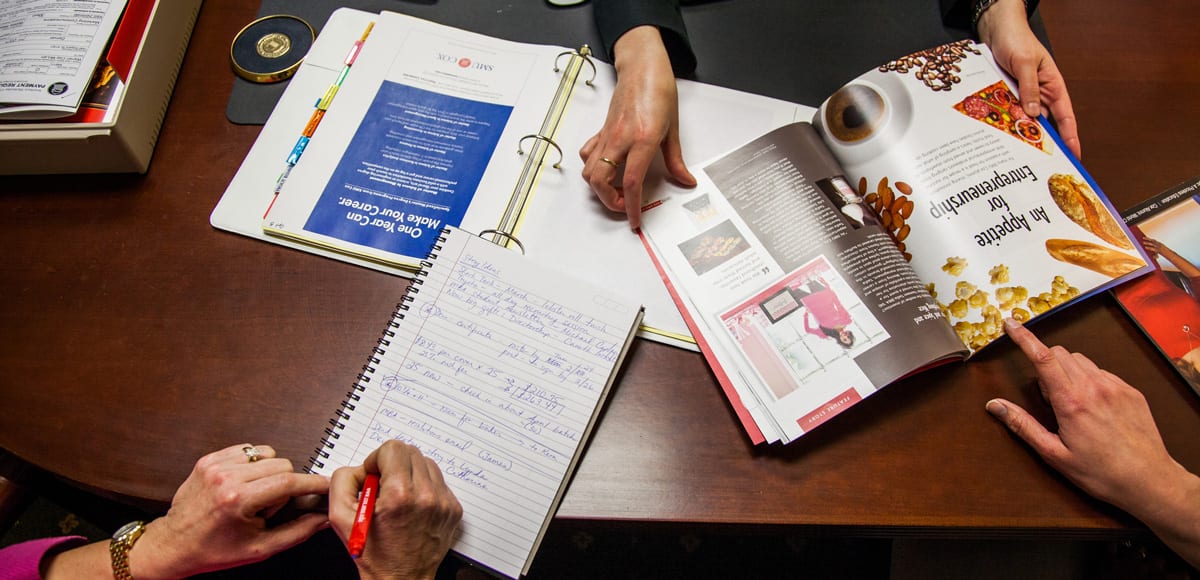 Along with Finance and Facilities, the Office of Information Technology (OIT) is one of the three key areas of campus that has moved to a Shared Services model over the past year. The leadership team recently sat down to talk about their challenges and successes so far, and their plans for the future:
Along with Finance and Facilities, the Office of Information Technology (OIT) is one of the three key areas of campus that has moved to a Shared Services model over the past year. The leadership team recently sat down to talk about their challenges and successes so far, and their plans for the future:
OIT Shared Services Leadership
[TN] – Teena Newman, Director of Project Management Office
[RM]—Rachel Mulry, Director of Customer Service
[JW]—Jason Warner, Director of Academic Technology Services
[DN]—David Nguyen, Director of Infrastructure
[CH]—Curt Herridge, Director of Applications
[JG] – Joe Gargiulo, CIO
Where is your organization in the Shared Services transition process?
[JG] – We have made tremendous progress, but still have a lot of work to do. Consider when IT Shared Services started – I believe the week before school started! From an operational perspective, that was an incredibly challenging time to make such significant changes. We had to move slowly with any changes we wanted to make in order not to disrupt operations. We had a lot to learn about the folks who were transitioning to OIT as well. Some time has passed and things are settling down, allowing us to truly begin to put in place the Shared Services strategies that we designed. Over the next 4-5 months we’ll make even more strides towards our vision of IT Shared Services. Clearly, the most challenging times are behind us! I would like to thank the SMU leadership for their incredible support during this very challenging transition period. There are a lot of moving pieces and we are definitely making structural changes and have had some disruptions, but almost everyone has been extremely supportive and understanding!
[RM]— The Customer Service department has completed many of the logistics in terms of geographically locating people throughout campus and establishing primary procedures/protocol for engaging the various support teams. We are still adjusting processes and working on skills/knowledge across the groups. That part of the process will take several more months before we settle in.
[JW]—The Academic Services team has completed 80% of our team’s hiring and hopes to have everyone hired and in place by June 1. While many team members are still adapting to new process and workflow changes characterized by the newly centralized service organization, we are finally moving out of the very limited “keeping the lights on” mode of service. We are beginning the process of marketing and communicating the “new” Academic Services team and its specific services to SMU’s various academic communities.
What has been the biggest surprise you’ve encountered during the transition?
[TN] – Inconsistencies. I believe it is up to us as the OIT leadership team to provide clear direction, so as a new unit we can have a consistent approach.
[RM]— IT was being implemented in such silos across campus. There was a lack of understanding from all groups as to what services were being provided and what was available to campus. It’s been refreshing to not only solve problems quickly (just by better awareness of IT services) but to also identify processes that were working well in each area and extend those to other areas of campus.
What has been the most challenging aspect of this transition?
[JG] – Timing, complexity, magnitude of the task, resistance to change, emotional reactions, stress, making significant infrastructure changes without disrupting service and dealing with a major hardware failure in the midst of the transition!
[DN]— Lack of consistency.
[CH]— Negotiating past duties and future duties of new employees.
What are the top priorities for your organization right now?
[JG] – Continuing with the IT Shared Services transition; filling remaining open positions; getting folks focused and transitioned to their new roles; completing the college IT infrastructure transitions and managing 70 other projects at the same time; ensuring effective communication to campus throughout the transition; reviewing our service portfolio for opportunities to save money and be more effective; creating staff opportunities; reviewing job titles, levels and salaries.
[RM]—
• Technology Fund replacements and upgrades for classrooms and desktops.
• Standardization of labs across campus to ensure that these environments are secured, updated, and more easily manageable to support the faculty and students.
• Proactive improvements for classroom systems (remote control of AV to help address many of the calls for classroom dispatch).
• Training and skill development.
[JW]—
• Changing the entire IT culture—both from Shared Services “swept” employees and pre-existing IT areas—and bringing together previously separate groups of service providers has been challenging but is essential to success.
• Migrating from Blackboard to Canvas.
• Installing the Academic Team staff overlay consistently and assertively throughout all areas of SMU.
• Implementing a system of quantitative measurement for academic support systems.
• Sustaining, building or re-building trust and service confidence between OIT and academic units.
What is the most frequently asked question you’ve received about Shared Services and how do you respond?
[RM]— “Where do I go for help? Who do I contact?” The best answer by far is to contact our Help Desk. They are open 7 days a week and can connect you with the appropriate personnel if they are not able to resolve it themselves.
[CH]— Q: Unhappiness about giving up resources. A: This is the shared services mandate, and we can make the University better together.
How has your organization changed with the addition of your newest team members?
[RM]— It has certainly grown in complexity as employees are located all over campus. That presents numerous communication and management challenges. It has allowed us to improve our response times, however, with the expanded help desk and additional desktop support staff.
[JW]—OIT has assimilated a huge number of previously localized and decentralized IT employees. As it happens, I’d thought that the greatest “change” challenge would be to convince my new group of the merits of changing into a new academic team with all of the benefits that shared services can offer. My greatest challenge has actually been introducing a team with different service values and service culture into an organization that is also struggling with culture change I would say that the organization is changing to include expanded and different service perspectives, but that change has been slow and is still in progress.
[DN]— Added visibility into existing processes that was not available before.
What key improvements have you seen so far?
[JG] – Unified IT leadership, support and buy-in from most of the staff, increased focus on project management, improved change management and communications, keen interest by most to improve our operations and effectiveness.
[RM]— Expanded help desk staffing, hours, etc. The additional staff has allowed us to meet the demand more consistently and provide better service. Utilizing the help desk, desktop team and AV team to respond to classroom dispatch calls has been effective, although a little bumpy. We have been able to respond to calls more quickly. The Training and Communication team has been able to expand its offerings to meet some critical support needs (Canvas implementation, Altshuler Learning Enhancement Center partnership to deliver training for students, etc.) Finally, being on one team allows us to streamline some critical client management processes to reduce confusion and ensure a more stable client experience from software delivery to patching. This is still very much in progress, but we are making headway!
[JW]—
• Entirely new team of visionary IT directors who believe in the mandate and promise of IT Shared Services —and also believe in each other.
• Consolidation of anachronistic localized technology infrastructure.
• Creation of a new, logical and comprehensive academic technology support model for SMU faculty.
• Cross-functional team potential.
Anything else you would like to share?
[JG] – Thanks and appreciation to the president and our senior leadership for their amazing support and patience with OIT as we work through this very challenging transition. Thanks and appreciation to all of OIT for working so hard to make this transition work!
[JW]—Throughout this process, assistance and support from some of the University’s leadership has been critical and well-received. One SMU dean encouraged me by reminding me that a process and change of the magnitude of Shared Services is going to take several years to normalize. Big-picture realities facing higher education in general require perpetual transformation and reinvention in order to remain sustainable and competitive—I believe that IT Shared Services paves the right way for future IT service at SMU. My greatest hope is that SMU continues to equip the new “boilerplate” Shared Services areas with the time, resources and mandates required to ensure long-term success.



